Ukraine will become a Nato member subject to reforms after the war, says secretary general
Ukraine will become a member of Nato, the military alliance’s secretary general, Jens Stoltenberg, has said.
Allies agree that Ukraine will become a member of Nato. At [the Nato-Ukraine] meeting, we will agree recommendations for Ukrainians … reforms, as we continue to support Kiev on this path to Nato membership.
However, all allies still agree that full membership remains impossible in the midst of war, even while ways to move Ukraine and Nato closer continue, he added.
This month Germany and the Netherlands pledged €10bn for Ukraine, he added. Romania added a F16 training centre for Ukrainian pilots. Allies including the US and Finland are sending more air defences and ammunition to protect Ukrainian cities from Russian attacks.
Stoltenberg also said that Sweden’s pending Nato membership “will make us all safer” and he called on Turkey and Hungary to complete its ratifications.
Key events
US secretary of state Antony Blinken is turning his attention to Ukraine, Nato and the Western Balkans after weeks of intense focus on Israel’s war against Hamas in Gaza, AP reports.
Blinken has spent much of the last month-and-a-half deeply engaged on the Gaza crisis, making two trips to the Middle East. Now, amid signs that a cease-fire agreement between Israel and Hamas due to expire on Monday may be extended, Blinken is departing for Brussels for a Nato foreign ministers meeting.
In Brussels, the alliance will reaffirm its support for Ukraine’s defence against Russia’s invasion, explore ways of easing tensions between Kosovo and Serbia and look at preparations for Nato’s 75th anniversary next year.
The two-day session on Tuesday and Wednesday will include the first foreign minister-level meeting of the Nato-Ukraine Council, a body created by alliance leaders at their last summit to improve cooperation and coordination and help prepare Kyiv for eventual membership.
“Allies will continue to support Ukraine’s self-defence until Russia stops its war of aggression,” said Jim O’Brien, the top US diplomat for Europe.
Finland considers the inflow of asylum seekers from Russia a national security issue, the prime minister, Petteri Orpo, has said.
Orpo said his country expects more asylum seekers to arrive at its border via Russia and plans to take further measures to stem the flow after closing all but one entry point in recent weeks.
“Intelligence information from different sources tells us that there still are people on the move… If this continues, more measures will be announced in the near future,” he told a press conference.
Some 900 asylum seekers from nations including Afghanistan, Kenya, Morocco, Pakistan, Somalia, Syria and Yemen have entered Finland from Russia in November, an increase from less than one per day previously, according to the Finnish Border Guard.
Finland blames a change in Russian border protocol for the increase, and calls this a hybrid attack. Moscow has denied the charge.
Heavy snow has caused power outages in more than 2,000 towns and villages across 16 regions of Ukraine (see 9:45). Here are some of the latest images from the news wires.

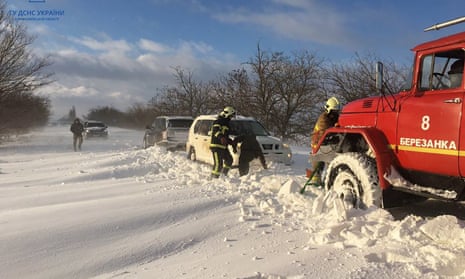
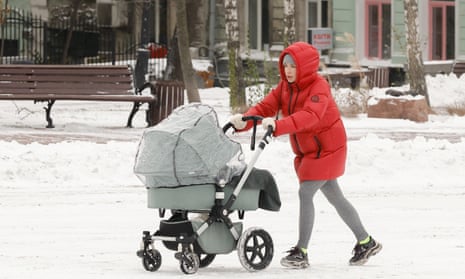
Here is a selection of the Russia-Ukraine war photos which have made AFP’s pictures of the year.
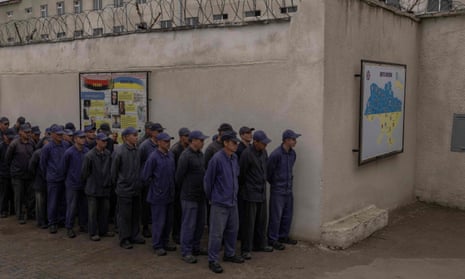
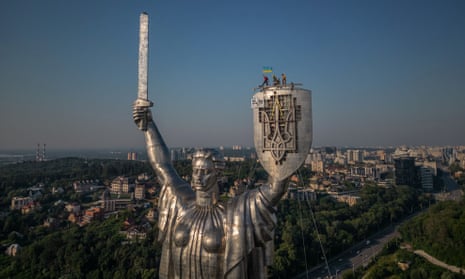
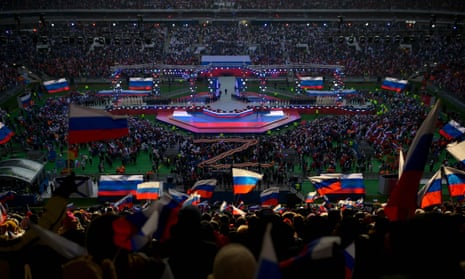

There are now almost 300,000 Ukrainian children registered in Polish educational institutions, including about two-thirds who fled the Russian invasion with their families, according to the Ukrinform agency.
As of this month, there are more than 286,000 Ukrainian children studying in Poland, BBC Russia cites Ukrinform as saying, from Polish education ministry data. Two-thirds of these children fled Ukraine from February last year, according to the data.
However, according to Ukrinform, another 200,000 Ukrainian children may be living in Poland but are not attending Polish educational institutions. More than 3 million Ukrainains now live in Poland, with about half arriving since the Russian invasion.
Ancient Scythian artefacts from museums in Russian-occupied Crimea have been returned to Ukraine after a legal dispute over ownership rights during which they spent almost a decade in the Netherlands, a Ukrainian museum has said.
More than a thousand artefacts, including a solid gold Scythian helmet and golden neck ornament, were on loan to Amsterdam’s Allard Pierson Museum when Russian troops seized and annexed the peninsula in 2014. Both Ukraine and the museums located on the Moscow-controlled territory claimed ownership rights when the exhibition ended, reports Reuters.
“After almost 10 years of court hearings, artifacts from four Crimean museums that were presented at the exhibition ‘Crimea: gold and secrets of the Black Sea’ in Amsterdam have returned to Ukraine. The Allard Pierson Museum handed them over to the National Museum of History of Ukraine,” Ukraine‘s national museum said.
It said the collection would be stored in the national museum until the de-occupation of Crimea. The Allard Pierson Museum said the artifacts had been returned to Kyiv on Sunday.
Ukrainian customs services reported that a truck carrying “2,694 kg of cultural property” entered the 980 year-old Kyiv-Pechersk Lavra monastery complex, where a further identification process would take place.
“This was a special case, in which cultural heritage became a victim of geopolitical developments,” said Els van der Plas, director of the Allard Pierson. “We are pleased that clarity has emerged and that they have now been returned.”
In June, the Dutch Supreme Court ruled the items should be returned to Ukraine. Kyiv sees the artefacts as part of its national heritage, while the Moscow-controlled museums said they had to return to the peninsula due to loan terms.
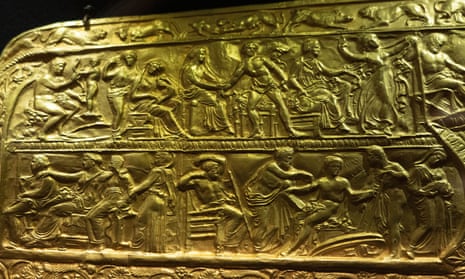
The Russian foreign minister, Sergei Lavrov, has said that he would take part in an OSCE meeting in North Macedonia if Bulgaria opened its airspace, and that some western countries had asked for meetings with him.
“Apparently Bulgaria has promised Macedonia it will open its air space – if that happens then we will be there. Let’s see,” Lavrov told a conference in Moscow. “There are already several requests for meetings, including from western representatives.”
He met the US secretary of state, Antony Blinken, at the G20 last year. Lavrov added: “If someone approaches us, we never run away or hide.”
Foreign ministers of the Organization for Security and Cooperation in Europe are due to meet in Skopje from 30 November to 1 December.
Bulgarian airspace is closed to Russian aircraft as part of EU sanctions imposed in response to Russia’s invasion of Ukraine in February 2022.
Russian forces advanced around Avdiivka over weekend, says US thinktank
Russian forces have made confirmed advances north-west and south-east of Avdiivka over the weekend, according to the US-based Institute for the Study of War.
Russia continued to intensely attack the eastern town of Avdiivka and the southern village of Robotyne, where fighting has centred in recent weeks, Ukraine said today. “The enemy continues offensive actions near Avdiivka.”
It said Moscow’s forces had launched “more than 150” attacks on Ukrainian positions in villages around the town. Yesterday, Ukraine said it had “repelled” two dozen attacks around Avdiivka, AFP reports. Kyiv did not report gains or losses in the area.
Moscow controls territory to the north, east and south of Avdiivka, which lies just 10km from the Moscow-held city of Donetsk.
In the south, Kyiv said Russian forces had “conducted around 20 attempts to restore lost position near Robotyne of the Zaporizhzhia region, but gained no success”.
Ukraine recaptured the tiny village of Robotyne in August, announcing a strategic victory in its counter-offensive. But Russia has attacked Robotyne since, with Ukraine appearing to struggle to hold on.
The Nato secretary-general says that some of the most intense fighting of the war has taken place in recent weeks in the east of Ukraine.
[It is an] extremely difficult situation along the front line, especially in the east. We see high casualty numbers and some of the most intense fightings that we have seen throughout the whole war has actually taken place over the last weeks and couple of months.
At the same time, the frontline has not shifted in any significant way, so I think we need to distinguish between the fact that the frontline is not moving so much and the fact that actually there is very heavy fighting going on.
Again we are impressed by the bravery, the competence of the Ukrainian forces, and also their ability to actually strike behind the Russian lines, deep into Russian controlled territory. And of course military achievements can partly be measured in square meters but also on the losses you are able to inflict on your adversary.
Stoltenberg says that Ukraine will be free to negotiate whatever peace it wishes to agree with Russia, when and if the time comes for peace talks.
It is for Ukraine to decide what are acceptable ways to end this war. Our responsibility is to support Ukraine and to enable them to liberate as much land as possible and to put them in the best possible place, when or if negotiations may start.
Wars are by nature unpredictable. We have seen no sign that president Putin is planning for a peace, he is actually planning for more war. So what we do know is that the more military support we provide to Ukraine, the stronger their position will be on the battlefield and the stronger their position will be on a potential negotiating table
Some further quotes from the press conference with Stoltenberg.
Nato allies are following up and implementing the decisions we made on Ukraine and Nato membership at our summit in Vilnius in July this year. We made three important decisions. First of all we shortened Ukraine’s path to membership from a two-step process to one step process by removing the requirement for a membership action plan for Ukraine, so that step has already been taken.
Second, we have established a Nato-Ukraine Council which is an important body where Ukraine and all Nato allies meet around the same table with the same rights, the same obligations, and that’s a body where you can make decisions together, so that moves Ukraine of course significantly closer to Nato by establishing a decision making body. That council will meet for the first time at the foreign ministerial level this week.
Thirdly we have agreed a comprehensive, substantial program for ensuring full interoperability between Ukrainian forces and Nato forces. This will of course help them also to come closer to us, that they are more capable of operating together with Nato forces. On top of that, of course, the fact that Nato allies are delivering F-16s, battle tanks, artillery, training; all of that is in a very practical way, helping Ukraine to come closer to Nato because they are more and more capable of operating and working together with Nato soldiers and based on Nato doctrines and and training procedures.
It’s too early to say exactly what we will be the decision at the Washington summit. All allies agree that in the midst of war full membership is not possible but of course we will continue to look into to address how we can move Ukraine and Nato even closer together.
Ukraine will become a Nato member subject to reforms after the war, says secretary general
Ukraine will become a member of Nato, the military alliance’s secretary general, Jens Stoltenberg, has said.
Allies agree that Ukraine will become a member of Nato. At [the Nato-Ukraine] meeting, we will agree recommendations for Ukrainians … reforms, as we continue to support Kiev on this path to Nato membership.
However, all allies still agree that full membership remains impossible in the midst of war, even while ways to move Ukraine and Nato closer continue, he added.
This month Germany and the Netherlands pledged €10bn for Ukraine, he added. Romania added a F16 training centre for Ukrainian pilots. Allies including the US and Finland are sending more air defences and ammunition to protect Ukrainian cities from Russian attacks.
Stoltenberg also said that Sweden’s pending Nato membership “will make us all safer” and he called on Turkey and Hungary to complete its ratifications.


